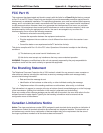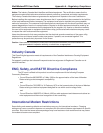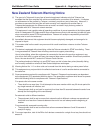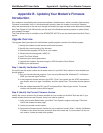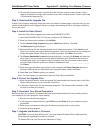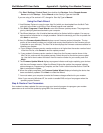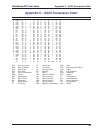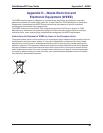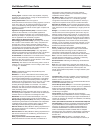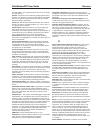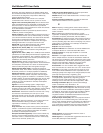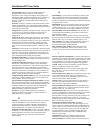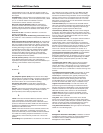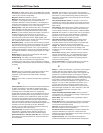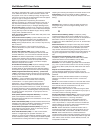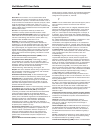
Glossary
36
MultiModemZPX User Guide
A
Analog signal: A waveform which has amplitude, frequency
and phase, and which takes on a range of values between its
maximum and minimum points.
Analog Transmission: One of two types of
telecommunications which uses an analog signal as a carrier of
voice, data, video, etc. An analog signal becomes a carrier
when it is modulated by altering its phase, amplitude and
frequency to correspond with the source signal. Compare with
digital transmission.
Application Program Interface (API): A software module
created to allow dissimilar, or incompatible applications
programs to transfer information over a communications link.
APIs may be simple or complex; they are commonly required to
link PC applications with mainframe programs.
ASCII (American Standard Code for Information
Interchange) (pronounced “askey”): A binary code for data
that is used in communications and in many computers and
terminals. The code is used to represent numbers, letters,
punctuation and control characters. The basic ASCII code is a
7-bit character set which defines 128 possible characters. The
extended ASCII file provides 255 characters.
Asynchronous Transfer Mode (ATM): A very high-speed
method of transmission that uses fixed-size cells of 53 bytes to
transfer information over fiber; also known as cell relay.
AT Commands: A standard set of commands used to configure
various modem parameters, establish connections and
disconnect. The “AT” is used to get the “attention” of the modem
before the actual command is issued.
Availability: The measure of the time during which a circuit is
ready for use; the complement of circuit “outage” (100% minus
% outage = % available).
B
Babble: unexpected bus activity that persists beyond a
specified point in a frame.
Backbone: 1. A set of nodes and their interconnecting links
providing the primary data path across a network. 2. In a local
area network multiple-bridge ring configuration, a high-speed
link to which the rings are connected by means of bridges. A
backbone may be configured as a bus or as a ring. 3. In a wide
area network, a high-speed link to which nodes or data
switching exchanges (DSEs) are connected. 4. A common
distribution core that provides all electrical power, gases,
chemicals, and other services to the sectors of an automated
wafer processing system.
Background: An activity that takes place in the PC while you
are running another application. In other words, the active user
interface does not correspond to the ‘background’ task.
Bandwidth: the amount of data transmitted per unit of time,
typically bits per second (bps) or bytes per second (Bps).
Bell Operating Companies (BOC): The family of corporations
created during the divestiture of AT&T. BOCs are independent
companies which service a specific region of the US. Also
called Regional Bell Operating Companies (RBOCs).
Bell Pub 41450: The Bell publication defining requirements for
data format conversion, line conditioning, and termination for
direct DDS connection.
Bell Pub 62310: The Bell publication defining requirements for
data format conversion, line conditioning, and termination for
direct DDS connection.
Binary Synchronous Communication (BSC): A form of
telecommunication line control that uses a standard set of
transmission control characters and control character
sequences, for binary synchronous transmission of binary-
coded data between stations.
Bit (Binary digit): A bit is the basis of the binary number
system. It can take the value of 1 or 0. Bits are generally
recognized as the electrical charge generated or stored by a
computer that represent some portion of usable information.
Bps (bits per second): A unit to measure the speed at which
data bits can be transmitted or received. Bps differs from baud
when more than one bit is represented by a single cycle of the
carrier.
Bridges: 1. A functional unit that interconnects two local area
networks that use the same logical link protocol but may use
different medium access control protocols. 2. A functional unit
that interconnects multiple LANs (locally or remotely) that use
the same logical link control protocol but that can use different
medium access control protocols. A bridge forwards a frame to
another bridge based on the medium access control (MAC)
address. 3. In the connection of local loops, channels, or rings,
the equipment and techniques used to match circuits and to
facilitate accurate data transmission.
Buffer: A temporary storage register or Random Access
Memory (RAM) used in all aspects of data communications
which prevents data from being lost due to differences in
transmission speed. Keyboards, serial ports, muxes and
printers are a few examples of the devices that contain buffers.
Bus: A common channel between hardware devices either
internally between components in a computer, or externally
between stations in a communications network.
Bus Enumeration: Detecting and identifying Universal Serial
Bus devices.
Byte: The unit of information a computer can handle at one
time. The most common understanding is that a byte consists of
8 binary digits (bits), because that’s what computers can
handle. A byte holds the equivalent of a single character (such
as the letter A).
C
Call Setup Time: The time to establish a circuit-switched call
between two points. Includes dialing, wait time, and CO/long
distance service movement time.
Capabilities: Those attributes of a Universal Serial Bus device
that are administerable by the host.
Carrier Group Alarm (CGA): A T1 service alarm generated by
a channel bank when an OOF condition occurs for a predefined
length of time (usually 300mS to 2.5 seconds). The CGA
causes the calls using a trunk to be dropped and for trunk
conditioning to be applied.
Carrier signal: An analog signal with known frequency,
amplitude and phase characteristics used as a transport facility
for useful information. By knowing the original characteristics, a
receiver can interpret any changes as modulations, and thereby
recover the information.
CCITT (Consultative Committee for International Telephone
and Telegraph): An advisory committee created and controlled
by the United Nations and headquartered in Geneva whose
purpose is to develop and to publish recommendations for
worldwide standardization of telecommunications devices.
CCITT has developed modem standards that are adapted
primarily by PTT (post, telephone and telegraph) organizations
that operate phone networks of countries outside of the U.S.
See also ITU.
Central Office (CO): The lowest, or most basic level of
switching in the PSTN (public switched telephone network). A



